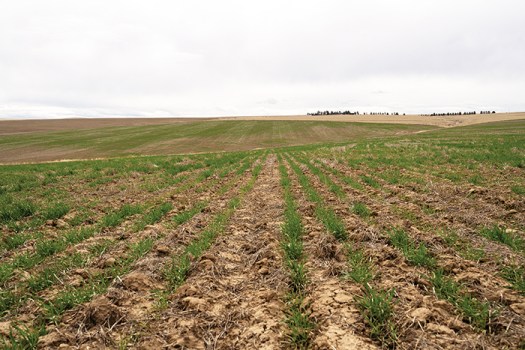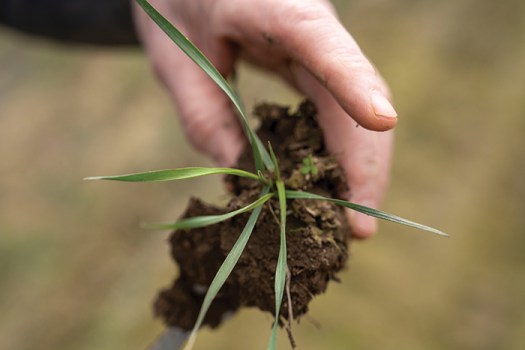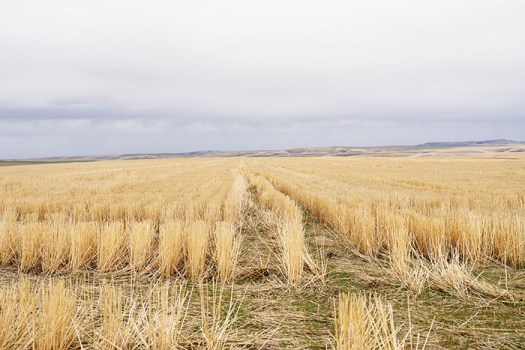Winter rains indicate average wheat yield for upcoming season in Columbia Basin
Published 2:33 pm Wednesday, April 16, 2025
IONE — Green wheat stalks just barely poked through the soil of a rolling hill in Ione as fourth-generation farmer Clint Carlson talked about the moisture content this winter.
“The thing is, you know, we’re at the mercy of the weather,” Carlson said. “ This time of year, you want calm weather so you can get out and get your field work done, but you’re always hoping for that next cloud to come over the hill and drop some rain.”
Carlson is one of many dryland wheat farmers in Morrow and Umatilla counties partway through the growing season of his winter wheat crop. Harvest is still months away, but as the wet season ends, he and other farmers are keeping close watch over their plants.
According to Carlson and Oregon State University Extension researchers based in Pendleton, the outlook for the wheat harvest is about average. In areas closer to the Blue Mountains in eastern Umatilla County, where it rained a little more over the winter, the yield may even be higher than normal.
Rainy season recap
In drier parts of the region, farmers like Carlson, who gets eight to 10 inches of rain per year, may average 35-40 bushels per acre, which is about what Carlson expects from the upcoming crop. The fall of 2024 was pretty dry, he said, though it did get wetter going into winter, which balanced out the lack of moisture. Unless a lot of rain comes in spring and early summer, he said, it will likely be an average year.
But the final outcome depends a lot on the last rains of the season coming during May and into June.
“ Sometimes you get it and sometimes you don’t,” he said. “Last year we did and that’s why we had a good crop. The year before, we didn’t hardly get any rain and we had a really bad crop.”
Francisco Calderon, director of OSU’s Columbia Basin Agricultural Research Center, said rains in the Pendleton area — a moderately dry region that sees an average of 16 inches of rain per year — were slightly above the average during part of the winter. February, for instance, had 1.9 inches of rain, which is about 128% above the 30-year average. And beyond that, the region isn’t currently in a drought, nor is one expected.
The rains refill the soil profile with moisture to sustain the wheat even when the heat comes in the summer, making it one of the most significant factors in the outlook for dryland wheat, which don’t get the benefit of irrigation from sprinklers.
“With all that in consideration, I would say that we are on track to hit good yield numbers this year,” Calderon said.
The Adams-based research station’s wheat crop may reach 100 bushels per acre or beyond if the rains continue, he said.
High costs, low prices
According to the United States Department of Agriculture’s Economic Research Service, nationally, overall wheat harvest was up in 2024 despite a decrease in acres planted. Wheat production has been declining since the 1980s, and is down by about 800 million bushels now compared to 1981.
In the Pacific Northwest, though, most of the wheat planted and harvested is soft white wheat, which is used for baked goods like cakes and pastries. Oregon, Washington and Idaho produce about 95% of soft white wheat that is exported, according to Amanda Hoey, CEO of the Oregon Wheat Commission and the Oregon Wheat Growers League.
Although yields nationwide might be up, costs are, too, and prices aren’t following.
“ We’ve certainly seen a continued period of low wheat prices, very competitive global markets on wheat,” said Hoey. “We have seen a rebound in some of those export sales, particularly for soft white wheat in comparison to last year, in particular, but we continue to experience low prices.”
Carlson echoed Hoey, adding that input costs — for things such as fuel, herbicide and fertilizer — since the pandemic have “just skyrocketed,” but prices per bushel generally haven’t.
“ It’s hard when your prices are so low,” Carlson said. “ It’s hard to put a budget together that you can cashflow a profit out of it and so we depend on crop insurance and those kind of things to help us out to make into the next year.”
Disease, weeds also a factor
Prices aren’t the only challenge wheat farmers contend with. Like other growers, they deal with diseases and weeds.
Stripe rust is a common fungal disease affecting wheat. Researchers are working to combat stripe rust susceptibility with disease-resistant wheat strains.
According to OSU, stripe rust spreads more easily in wetter and more humid conditions. The later the fungus appears, the better off a grower is, as that means the disease will have less time to spread. OSU’s Calderon said the cold spell in February, with temperatures dropping into the single digits, likely means stripe rust won’t be too bad this season.
Hoey said growers rely on plant pathologists to help monitor diseases and give early indicators of what to keep an eye out for. That helps them figure out what herbicides to use for weed control and how to approach disease spread.
Some diseases and weeds are becoming resistant to intervention. Russian thistle and mustards will compete with wheat for resources, Carlson said, so he’ll generally spray a broadleaf chemical sometime in April if it’s needed. He works with OSU’s weed scientist to combat Russian thistle and find herbicides it’s not resistant to.
Calderon said it’s similar to antibiotics in people.
“Antibiotics are changing their efficacy for controlling different infections,” he said, “so that’s kind of what’s going on with some herbicides.”
Harvest preparation
Between March and July, farmers will be preparing for harvest. This includes checking equipment, possibly spraying herbicides in areas that need it, and adding fertilizer if necessary to help the plants grow.
“ The healthier the crop, the less disease you have, the less weed pressure you have, and so you want to make sure that it is growing and it’s healthy and it matures with a good head, with lots of kernels and that kind of thing,” Carlson said.
Then, come July and into August, he’ll start harvesting when the wheat kernels are golden and crunchy. By September and October, the process will start over again.
For now, he and other growers will keep an eye on the sky and hope for those early summer rains.










